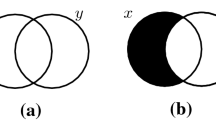Abstract
In this article, we describe a set of procedures and strategies for searching for proofs in logical systems based on the inference rule condensed detachment. The procedures and strategies rely on the derivation of proof sketches – sequences of formulas that are used as hints to guide the search for sound proofs. In the simplest case, a proof sketch consists of a subproof – key lemmas to prove, for example – and the proof is completed by filling in the missing steps. In the more general case, a proof sketch consists of a sequence of formulas sufficient to find a proof, but it may include formulas that are not provable in the current theory. We find that even in this more general case, proof sketches can provide valuable guidance in finding sound proofs. Proof sketches have been used successfully for numerous problems coming from a variety of problem areas. We have, for example, used proof sketches to find several new two-axiom systems for Boolean algebra using the Sheffer stroke.
Similar content being viewed by others
References
Barker-Plummer, D.: Gazing: An approach to the problem of definition and lemma use, J. Automated Reasoning 8(3) (1992), 311-344.
Bledsoe, W.: The use of analogy in proof discovery, MCC Tech. Report AI-2158-86, Microelectronics and Computer Technology Corporation, Austin, Texas, 1986.
Brock, B., Cooper, S., and Pierce, W.: Analogical reasoning and proof discovery, in E. Lusk and R. Overbeek (eds.), Proc. of the 9th International Conference on Automated Deduction, Lecture Notes in Comput. Sci. 310, Springer-Verlag, 1988, pp. 454-468.
Giunchiglia, F. and Walsh T.: A theory of abstraction, Artificial Intelligence 57(2, 3) (1992), 323-389.
McCharen, J., Overbeek, R., and Wos, L.: Complexity and related enhancements for automated theorem-proving programs, Comput. Math. Appl. 2 (1976), 1-16.
McCune, W.: OTTER 3.0 reference manual and guide, Technical Report ANL-94/6, Argonne National Laboratory, Argonne, IL, 1994.
Meredith, C.: Equational postulates for the Sheffer stroke, Notre Dame J. Formal Logic 10 (1969), 266-270.
Plaisted, D.: Abstraction mappings in mechanical theorem proving, in W. Bibel and R. Kowalski (eds.), Proc. of the 5th International Conference on Automated Deduction, Lecture Notes in Comput. Sci. 87, Springer-Verlag, 1980, pp. 264-280.
Robinson, J.: Automatic deduction with hyper-resolution, International J. Comput. Math. 1 (1965), 227-234.
Sacerdoti, E.: Planning in a hierarchy of abstraction spaces, Artificial Intelligence 5 (1974), 115-135.
Sheffer, H.: A set of five independent postulates for Boolean algebras, with application to logical constants, Trans. Amer. Math. Soc. 14 (1913), 481-488.
Veroff, R.: Canonicalization and demodulation, Technical Report ANL-81/6, Argonne National Laboratory, Argonne, IL, 1981.
Veroff, R. and Wos, L.: The linked inference principle, I: The formal treatment, J. Automated Reasoning 8(2) (1992), 213-274.
Veroff, R.: Using hints to increase the effectiveness of an automated reasoning program: Case studies, J. Automated Reasoning 16(3) (1996), 223-239.
Veroff, R.: Axiom systems for Boolean algebra using the Sheffer stroke, Technical Report TRCS-20, Computer Science Department, University of New Mexico, Albuquerque, New Mexico, 2000.
Veroff, R.: Short 2-bases for Boolean algebra in terms of the Sheffer stroke, Technical Report TR-CS-25, Computer Science Department, University of New Mexico, Albuquerque, New Mexico, 2000.
Veroff, R.: http://www.cs.unm.edu/~veroff/BA/, 2000.
Wolfram, S.: Correspondence by electronic mail, February 4, 2000.
Wolfram, S.: A new kind of science, http://wolframscience.com, 2000.
Wos, L., Veroff, R., Smith, B., and McCune, W.: in R. Shostak (ed.), The Linked Inference Principle, II: The User's Viewpoint, Proc. of the 7th International Conference on Automated Deduction, Lecture Notes in Comput. Sci. 170, Springer-Verlag, 1984, pp. 316-332.
Wos, L.: Automated reasoning and Bledsoe's dream for the field, in R. Boyer (ed.), Automated Reasoning: Essays in Honor of Woody Bledsoe, Kluwer Academic Publishers, Dordrecht, 1991, pp. 297-345.
Author information
Authors and Affiliations
Rights and permissions
About this article
Cite this article
Veroff, R. Solving Open Questions and Other Challenge Problems Using Proof Sketches. Journal of Automated Reasoning 27, 157–174 (2001). https://doi.org/10.1023/A:1010639725972
Issue Date:
DOI: https://doi.org/10.1023/A:1010639725972




